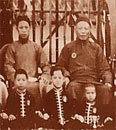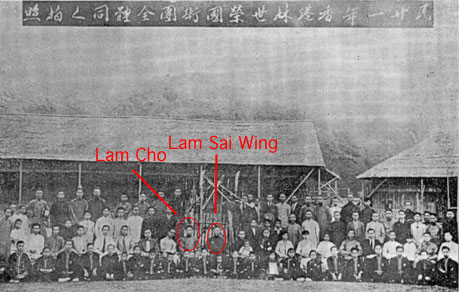Lam
Sai Wing Family Tree
This lineage table was revised by the Lam Sai Wing Alumni
Association between December 1951 and 1953. Lam Sai Wing
had many disciples; therefore, we only put those students'
names inside this table of their own free will. At that
time, they had to submit their own personal biographical
information and clearly indicate the school where they learned
and whose students they were. The photos and other articles
by Lam Sai Wing's students further corroborate this assertion.

A biography of Lam Sai Wing, written in 1951
by his student, Wong Man Kai, states that Kwan Kun, Tam
Chan, Tang Yee, and Tang Fong were the students of Lam Sai
Wing who accompanied the old master to the Lok Sin theater
in Guang Shou, where they were ambushed by armed Ching government
troops and fought their way out.
 

The following is Lam Cho's biography, written
in 1951 by Wong Man Kai, Lam Sai Wing's student. The biography
lists Lam cho's students who were publicly teaching in Hong
Kong in the 1950s: Chan Han Chung, Ho Si Kit, Chiu Kau,
and Wong Lei.
Lam Cho came from Pan Chao in Guangshou. An orphan, he was
adopted and raised by his uncle, Lam Sai Wing. When his
uncle went to Hong Kong, he went with him to learn martial
arts. He was blessed with quick arms, a strong body, and
superior physical dexterity. His uncle loved him as his
own son, and taught him in the authentic martial arts tradition.
He was highly intelligent, and quick to understand all the
different styles of kung fu. Throughout his twenty years
with his teacher, he accumulated vast experience in kung
fu and the art of Chinese medicine. By virtue of his medical
expertise, he helped thousands of people. As a young man,
he was already helping his Sifu in teaching at the Southern
Martial Arts Association and eventually set up his own kung
fu studio. His skill was so well known, that people thoughout
the South referred to him as Sifu even as a young man. He
set up another studio in Kowloon, where thousands of students
trained. His closest students set up studios to teach as
well; thus, those who had his teaching spread across Hong
Kong and Guangzhou, and the Hung Gar style became a shining
example of excellence in martial arts. Some of Lam Cho's
more notable students include Chan Hon Chung, Wong Lee,
Chiu Kau, Tang Kwok Wah, Kwong Tit Fu, Lee Yat Ming, Wong
Yiu Ching, and Kwong Buck Sam. All of them have opened up
Kung Fu schools of great renown.
Grandmaster Lam was well respected and was invited to give
demonstrations for the Navy and Army. Both Chinese and foreigners
complimented his performance, and his photo was soon appearing
in London newspapers. The school of martial arts spread
throughout the globe, enhancing the reputation of the Lam
family and the Hung Gar style. Grandmaster Lam traveled
far and wide, and never tired of teaching the style his
Sifu taught him. He was especially happy and willing to
help newcomers to the art. Many of the students that he
trained went on to develop great reputations for themselves.
All were grateful for his noble deeds, but grandmaster Lam
remained humble and peaceful, and was therefore well respected.

When the Japanese invaded Hong Kong, grandmaster
Lam's studio burned down, and fighting broke out all across
the city. Grandmaster Lam helped maintain the peace and
aided the peple in their suffering, and his deeds are still
remembered to this day. When Hong Kong fell, the Japanese
forces went looking for grandmaster Lam, so he returned
in secrecy to his village. When the people of his village
heard of his return, they immediately entreated him to teach
martial arts. Finally, after Hong Kong was liberated, he
returned to Hong Kong and set up his studio. He taught,
gave medical care, and served as national martial arts consultant
for various unions and workers associations. His medical
skill was superb, and his principles were especially admirable;
he did not take more from the rich, but nonetheless reduced
his fees for the poor, to the point of providing free service
and medicine. He was compassionate and generous. He accomplished
a great deal in his youth, and still enjoys researching
and discussing medicine and martial arts every day. The
future still holds much in store for grandmaster Lam.
|
